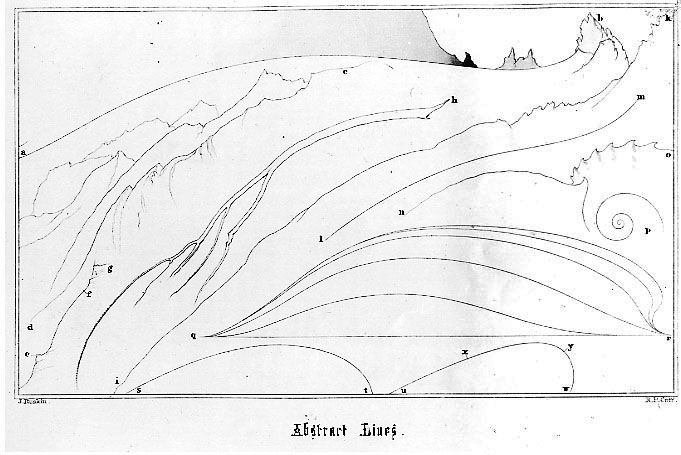
Even in 1853, John Ruskin was already through with digital exuberance. A drawing showing that natural lines are more pleasing than ordered ones. Fractalicious.
From the Stones of Venice.
So I’ve been doing a lot of thinking about Tenleytown’s history. What can it do for us? What are the traces of the past buried in our daily lives? How have we adapted our environment? How can we continue to do so, in a more profound way. Let’s look at the traces of the pre-industrial past within the Fort Reno study area.
It shows the orientation of each building. Gray is for the cardinal grid. Purple buildings face the avenues, while light green ones face curvilinear roads. Blue ones were doing their own thing. Dark green buildings didn’t really fit in any one box. Orange buildings face roads we know to be historical.
Yeah, I know what you’re saying. We’ve all been here. But, and you don’t have to look at it, let me break this down.
The highlight of the series, for me, was (go straight to it) was Andrew Witt’s discussion of the much longer use of computer drawings than the architecture profession typically admits. Witt is director of research at Gehry Technologies, and spent a few years studying 19th-century mechanical tools to reliably draw the complex shapes desired by Beaux-arts architects but very challenging to obtain with the accuracy or precision needed to actually construct a building. So it’s a very interesting talk. Patrik Schumacher, on the other hand, does nothing but embarrass himself and bloviate.
Here are links to all of the sessions, each three hours long, except for the keynote, #4.
The answer to the question, BTW, was that drafting is dead, but sketching will be around as long as we have bodies. Seems simple enough, right?
So, in addition to the visible boundaries of the city, there are the invisible ones, ones that are really only legible to a bureaucracy, but have significant effects on the lives of residents. Because it affects individuals so young and even effects the parents, where someone goes to school seriously alters the social geography of cities. They decide where the majority of socialization occurs: in one school, in another school; in private schools, in public schools; in classrooms or in breakfast nooks.
When I was a wee little Flannie, attending Murch and carousing about my block, I had neighbors across the street whom I hardly knew. Why? They went to Janney. We met and played outside occasionally, but by 3rd grade, we both had already formed our social lives, and that was it. Our parents were likewise divided; they knew each other, but that was it. My street was the boundary between two schools and there was a palpable difference between the facing blocks.
In the Reno-Tenleytown-Tobago area, there are seven schools that provide Nursery school through Twelfth Grade education. Obviously, there’s also American University, but that’s not as relevant since its students are not shaped as much by boundaries and divisions. There are also any number of private and parochial schools students could attend, three of which are in the area, but with a minivan or a Volvo, you too can idle your car outside your child’s school. So let’s just do the public schools.
There are three kinds of areas: unprogrammed spaces like plazas, sidewalks, and walkways, spaces for programmed activities, and then mixed-traffic areas like alleys.
This is a figure-ground drawing of all the buildings, by use. Keep reading for breakdowns by use.